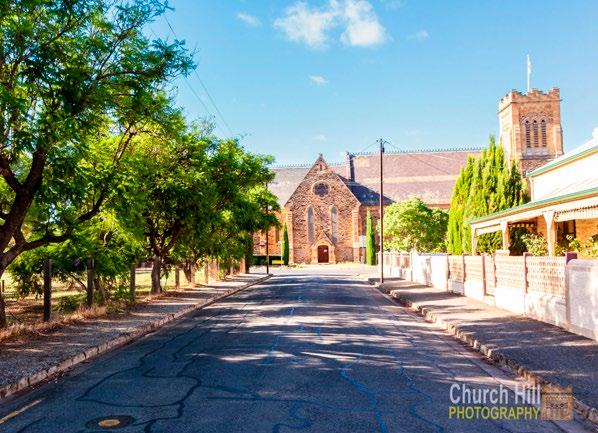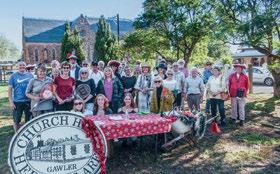
4 minute read
GAWLER DEVELOPMENT
PICTURED:
Above: Streetscape view of site along Cameron Street to St George’s Church. Bottom left: Tennis courts and adjacent houses, c 1903. Bottom right: View of Church Hill State Heritage Area with open space in centre.
Advertisement

GAwLER dEVELoPMENT PRoPosAL
highlights weakened heritage protections
Even south Australia’s seventeen state Heritage Areas are not safe from inappropriate development and vagaries under the state’s new planning regulations despite their accepted outstanding natural or cultural significance, as an ongoing battle on Gawler’s Church Hill makes clear.

when Colonel William Light planned the private township of Gawler in 1839, he chose a natural spur of land rising ten metres above the surrounding river flats as the axis for his design. Three main squares linked by Cowan Street were allocated free of charge to the Anglican, Catholic and Presbyterian denominations. Another site was set aside for the Methodists. Known as Church Hill, in 1985 this precinct became one of South Australia’s first State Heritage areas. Recognised for its distinctive character, it is today the residential area in Gawler that best retains its nineteenth century atmosphere. Now developers have set their sights on two of the original halfacre lots, owned by the Anglican Synod of Adelaide. Opposite St. George’s Anglican Church in Orleana Square, the land currently forms a park with tennis courts, trees and a stone shelter shed, at the corner of Cowan and Cameron streets. One lot at the site was originally allocated to the church for a clergy residence but St George’s Anglican school was built there instead. The school was demolished in 1891, leaving a stone “pony shed” shelter on the boundary. In 1902, two asphalt tennis courts were constructed. Later on netball was played there regularly, and a playground installed. A commemorative water fountain was erected in 1954 to celebrate the first Australian Royal tour by Queen Elizabeth II; several hundred Gawler Primary School students marched to the park for the opening ceremony. The playground was removed about fifteen years ago, but the stone shed and tennis courts remain as do commemorative plaques for the fountain and school. Used for coaching sessions and games, the courts are maintained by community members. A proposal for residential development on the site was first put forward by the Anglican church in 2006. It was withdrawn after significant public opposition. Then in March 2021 application was made by a private developer to demolish the tennis courts and remove trees on the Cameron Street boundary, some being “de facto” street trees. No details of further development were given. Third party appeal rights would have applied. After public submissions opposed the application, it was withdrawn without going to the Gawler council assessment panel. In June 2021 an identical application was submitted under the new Planning Development and Infrastructure Act. It was opposed by local residents and the Gawler Environment and Heritage Association, concerned about the loss of open space, absence of detail for future development, removal of the trees, the impact on the historic character of the area, and fears that it would set an “undesirable precedent”. The application went before the assessment panel in September 2021 and was unanimously rejected, despite a brief supporting statement from Heritage SA that the proposal would not diminish the area’s true heritage, backed by similar views from council planners. The applicant appealed. A nearby resident applied to be “joined” as a party to the development application so community objections could be heard under the new planning rules. This application was rejected by the ERD Court, mainly on the basis that the person lived more than 60 metres from the site. Another application was made by an adjacent resident and accepted by the ERD Court in January 2022. Meanwhile, the developer went back to the panel arguing for a reversal of its decision, backed by a submission from a prominent firm of heritage architects. The panel reversed its decision at a confidential meeting in December 2021, by a 4:1 vote. In a move most likely designed to avoid an appeal hearing, the developer recently lodged a third application to be considered by the panel in coming months. The new State Heritage Overlay and Planning Code has removed previous policies for the area under the Gawler Development Plan. “We now seem to just have some not to be enforced guidelines,” said long time Church Hill resident, Adrian Shackley. “No one is too sure what weight is given to the current “guidelines” for Church Hill published a few years ago by Heritage SA or the Management Plan [signed off by the Gawler council and State Heritage in 1998],” Mr Shackley said. “To make matters worse, if the applicant gets their “demolition” approval, future development is unlikely to be advertised for community comment and may be decided by Council planners under delegation. No input from the panel, none from community. We may not even know it is happening.” Sadly, this is another demonstration of the loss of community rights and a weakening of heritage protections under the Liberal Government’s retrograde Planning and Design Code.








